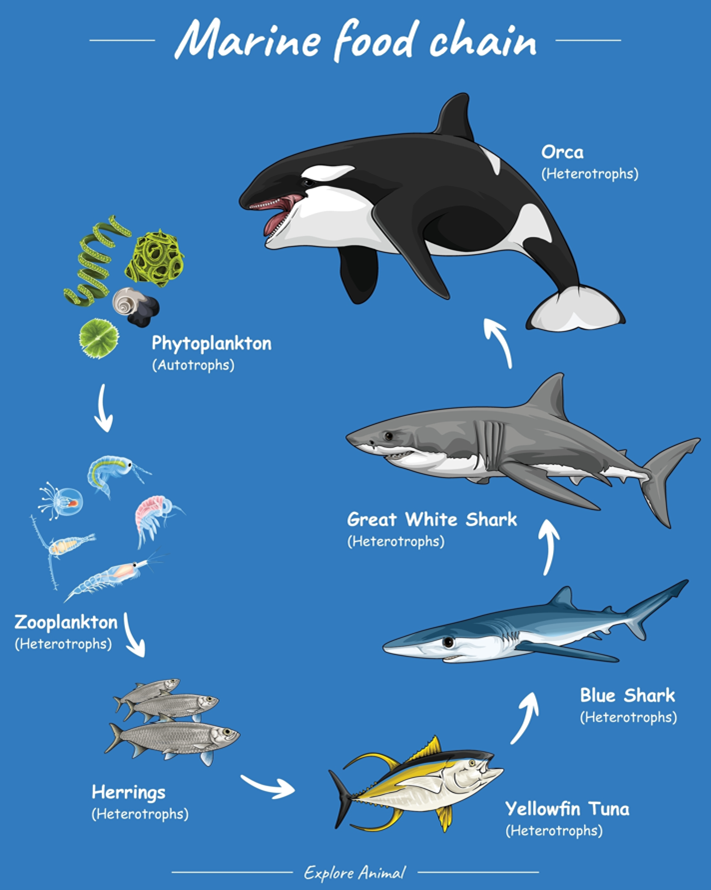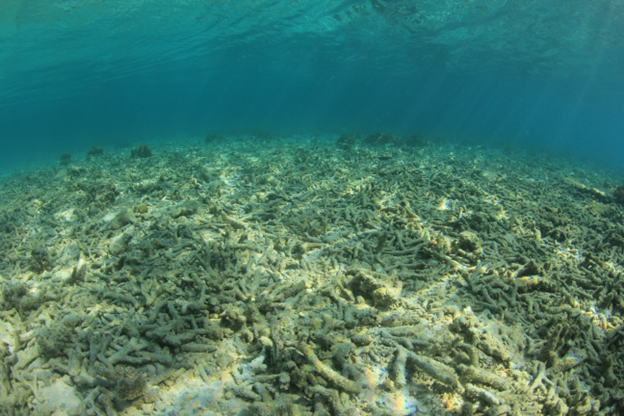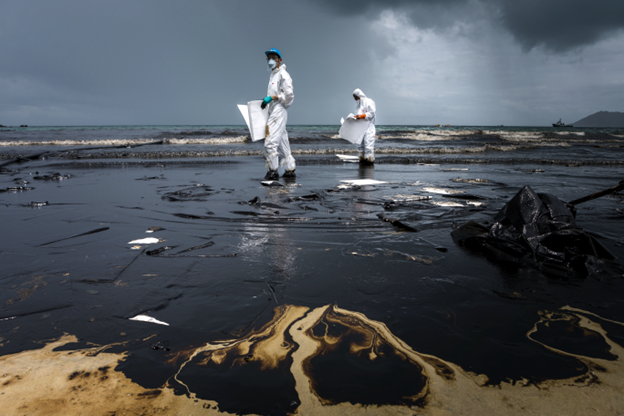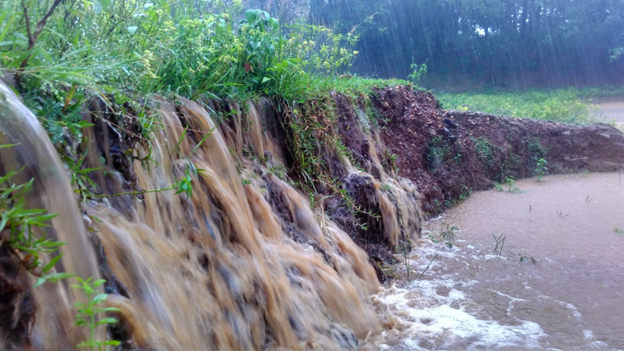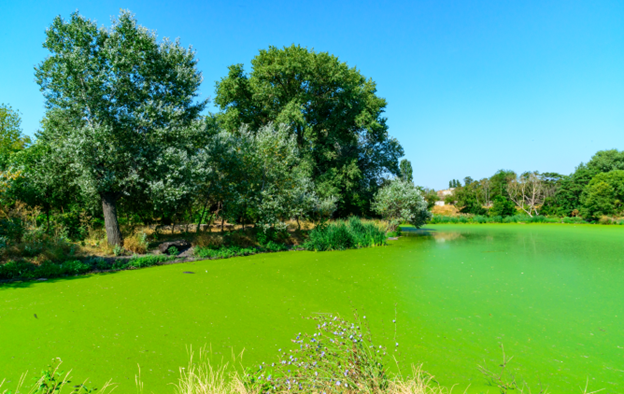Background: Overview of Food Webs in Marine Ecosystems and Their Impacts
Marine ecosystems are dynamic environments where a diverse range of species interact through complex food webs. A marine food web represents the interconnected relationships among organisms, illustrating the flow of energy and nutrients across different trophic levels. Unlike simple food chains, food webs depict multiple pathways of energy transfer, encompassing predator-prey relationships, symbiotic associations, and environmental interactions.
Understanding these food webs is crucial for maintaining biodiversity, ecosystem stability, carbon sequestration, and nutrient cycling (Eddy et al., 2021). At the base of marine food webs are primary producers, mainly phytoplankton, which use sunlight to convert carbon dioxide into organic compounds through photosynthesis. These producers form the foundation of aquatic ecosystems, supporting all higher trophic levels.
Small animals like zooplankton feed on phytoplankton, creating an essential link between primary producers and higher-level predators. Predators such as small fish consume zooplankton, and in turn, larger fish, marine mammals, and seabirds feed on these smaller fish. Each organism plays a vital role in maintaining the balance and functionality of marine ecosystems.
Marine food webs are inherently sensitive to external stresses, including overfishing, habitat destruction, pollution, and climate change. Human impacts can disrupt the intricate interactions within an ecosystem. For example, the removal of apex predators like sharks can lead to an overabundance of mid-level predators, which may overconsume herbivores or other prey species, resulting in trophic cascades that destabilize the entire ecosystem (Lennox et al., 2022).
Climate change significantly affects marine life through warming sea temperatures, ocean acidification, and deoxygenation. These changes can alter species distribution by disrupting reproductive cycles and migratory patterns. For instance, rising water temperatures may cause species to migrate to cooler areas, leaving ecological gaps that destabilize food webs (Lennox et al., 2022). Coral reefs, which are highly diverse ecosystems, are particularly vulnerable. Coral bleaching due to increased temperatures and acidification results in the loss of essential habitats for numerous marine organisms.
Additionally, plastic waste, especially microplastics, is ingested by marine organisms at all trophic levels. This ingestion can cause physical harm, obstruct digestive tracts, and lead to toxic chemical exposure (Pothiraj et al., 2023).
Suggested Activity: Modeling Marine Food Web Impacts
Objective: Understand marine food webs and the effects of environmental changes.
Materials:
– Poster paper or whiteboard
– Markers or colored pencils
– Images or drawings of marine organisms (from producers to apex predators)
– Yarn or string
– Tape or glue
Procedure:
1. Create the Food Web:
– Arrange pictures of marine organisms on the poster according to their trophic levels.
– Connect them with arrows to show who eats whom, illustrating energy flow.
2. Introduce Environmental Changes:
– Simulate scenarios like overfishing, pollution, or climate change by removing or altering certain species in the web.
3. Analyze the Impact:
– Discuss how these changes affect other organisms and the overall ecosystem.
– Observe cascading effects and potential disruptions in the food web.
4. Explore Mitigation Strategies:
– Brainstorm solutions such as sustainable fishing, reducing pollution, and protecting habitats.
– Discuss how these actions can help restore or stabilize the food web.
This activity will help to visualize marine food webs and understand the importance of each species within an ecosystem, emphasizing the impact of environmental changes and the need for conservation.
Future: Decline in Marine Species and Disruption of Food Chains
Industrialization and pollution pose significant threats to marine food webs, potentially leading to the decline of species and irreversible changes in ecosystems. According to the Food and Agriculture Organization (FAO), as of 2020, approximately 34% of global fish stocks were overfished, with many more at risk of becoming unsustainable (FAO, 2020). The decline in fish populations impacts predators that rely on them for food, disrupting predator-prey relationships and causing ecosystem imbalances.
Climate change exacerbates these threats. Rising sea temperatures lead to more frequent and intense marine heatwaves, causing mass die-offs among marine organisms. Coral bleaching events have devastated reefs worldwide, and without healthy coral reefs, numerous species that depend on them struggle to survive, further destabilizing the food web. Ocean acidification reduces the ability of corals, shellfish, and certain plankton species to build their shells and skeletons, leading to population declines that ripple through the food web.
Changes in ocean currents due to global warming can alter migration routes and predator-prey interactions. For example, if fish populations move to cooler waters, their predators may have to shift their ranges or face food shortages, triggering cascading effects throughout the ecosystem.
Mitigation: Beach Cleanups and Recycling Programs for Improved Food Webs
Mitigation measures are crucial to protect marine food webs. Beach cleanups help remove plastic waste and other debris from coastlines before they enter the ocean. Non-governmental organizations (NGOs) and local communities often organize regular cleanups to raise awareness about marine pollution and reduce the amount of plastic reaching marine environments.
However, cleanups alone are insufficient. Broader measures are needed to reduce plastic production and improve waste management systems. Governments and industries should implement effective recycling programs to prevent plastic waste from entering oceans. Public education on using biodegradable materials, reducing single-use plastics, and promoting circular economies is essential to minimize plastic pollution and its impact on marine ecosystems.
References
1. Eddy, T. D., Bernhardt, J. R., Blanchard, J. L., Cheung, W. W. L., Colléter, M., du Pontavice, H., … & Watson, R. A. (2021). Energy flow through marine ecosystems: confronting transfer efficiency. Trends in Ecology & Evolution, 36(1), 76-86. https://doi.org/10.1016/j.tree.2020.09.006
2. FAO. (2020). The State of World Fisheries and Aquaculture 2020: Sustainability in action. Rome. https://doi.org/10.4060/ca9229en
3. Lennox, R. J., Brownscombe, J. W., Darimont, C., Horodysky, A., Levi, T., Raby, G. D., & Cooke, S. J. (2022). The roles of humans and apex predators in sustaining ecosystem structure and function: Contrast, complementarity and coexistence. People and Nature, 4(5), 1258-1275. https://doi.org/10.1002/pan3.10385
4. Pothiraj, C., Gokul, T., Kumar, K. R., Arumugam, R., Palanichamy, A., Venkatachalam, K., … & Faggio, C.(2023). Vulnerability of microplastics on marine environment: A review. Ecological Indicators, 155, 111058. https://doi.org/10.1016/j.ecolind.2023.111058

